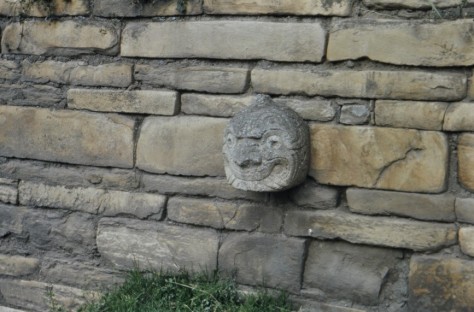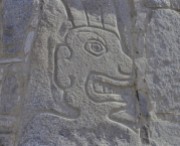During the three years that Steph and I lived in Peru between 1973 and 1976, we made several long-distance road trips. In those days, once you turned off the main coastal highway, the Panamericana, you left the asphalt behind and traveled only on graded dirt roads.
We also drove a car—a Volkswagen Variant—that had good clearance, and traveled comfortably on these roads. We had also fitted heavy-duty shock absorbers as well as a good set of radial tyres. So we were never concerned about leaving the paved highways. In fact, we often spent time during the weekends visiting one of our favorite destinations on the eastern side of Lima, climbing route 116 into the Andes mountains in the Santa Eulalia valley near Chosica. We enjoyed hunting for wild potatoes on the higher slopes.
In May 1973 and May 1974 I’d made two trips into the Departments of Ancash and La Libertad, and Cajamarca, respectively to collect cultivated varieties of potatoes to add to the world germplasm collection curated by the International Potato Center (CIP) for which I was working as a germplasm expert and Associate Taxonomist. Steph also worked in the germplasm program as an Associate Geneticist.
Both trips took me through some stunning landscapes, and interesting cities like Cajamarca. So, in June 1974 we made an eight-day trip to visit some of those same places. Joining us on the trip were our friends and fellow Brits, John and Marion Vessey. They were our witnesses when Steph and I married in October 1973, in the Lima suburb of Miraflores.

After our wedding ceremony in the Miraflores Municipalidad, we enjoyed lunch at the Granja Azul near Chosica.
John also worked as a plant pathologist at CIP on the same bacterial wilt disease that I’d spend several years studying when I transferred to Costa Rica in 1976. John’s work often took him to Cajamarca and beyond, almost always by road, a round trip of almost 1700 km.
Anyway, our plan was to visit the Callejon de Huaylas in Ancash, see the highest mountains in the country, and from there returning to the coast and traveling north to Cajamarca via Trujillo, taking in several interesting archaeological sites on the way both in the mountains and on the coast.
This was a round trip of almost 2800 km or thereabouts, and John and I shared the driving. Setting out from Lima early one morning, our first destination was Huaraz, the departmental capital of Ancash, in the heart of the Callejón de Huaylas, with the highest mountains of the Cordillera Blanca on the east side (including Peru’s highest peak, Huascarán) and the lower Cordillera Negra on the west (or coastal) side.
The gallery below shows Cordillera Blanca mountains at the southern approaches to the Callejón de Huaylas, near the turn-off to Chavín de Huántar. The last image in the gallery shows the Cordillera Negra on the western side of the Callejón de Huaylas.
The Callejón de Huaylas runs north-south, parallel to the coast, and was the site of a major earthquake in May 1970 that destroyed the towns of Ranrahirca and Yungay north of Huaraz, and killing tens of thousands of inhabitants. The gallery below shows where the landslide fell from Huascarán, with boulders the size of houses, obliterating Yungay and Ranrahirca. In Yungay, just a few palm trees and a statue of Christ at the cemetery were all that remained of the town in 1974.
We spent three nights in the turista hotel in Huaraz, traveling on the day after our arrival to Yungay, and then higher still to a lake nestling in a valley beneath Huascarán, Laguna de Llanganuco at 3850 m above sea level.
The day after we made a side trip of just under 100 km each way to the east of the Cordillera Blanca, to visit the ruins at Chavín de Huántar, a UNESCO World Heritage Site, built by a pre-Inc culture at least 3000 years ago.
On the journey to Chavín (I was driving at the time), and only a few km short of the town, I was coming round a blind bend, and found myself facing some difficulty to avoid a rather large rock in the middle of the road. So I attempted to straddle it, but was unsuccessful; some part of the chassis connected with the rock. It sounded bad, but a close inspection underneath the vehicle showed no visible damage, so we carried on. The next morning we loaded the car and set out due west from Huaraz to cross the Cordillera Negra before dropping down to the coast near Casma, where we planned to stop at the archaeological site of Cerro Sechín.
As we climbed out of Huaraz, I could hear unnerving creaks and groans emanating from behind me. So after about 30 minutes we stopped to make another inspection underneath. To my horror I saw that there was a visible crack in one of the shock absorber mounts. I could see daylight! I hadn’t realised just how hard I’d hit that rock the previous day.
Well, we couldn’t continue with that sort of damage, so I carefully reversed the car and we returned—slowly—to Huaraz and found a repair shop alongside the road. When the mechanic jacked up the car, the absorber mount gave way. In such a remote location there was no chance that any dealer would have the exact mount in stock. However, all was not lost, and with great skill the mechanic welded a piece of steel around the fracture, taking less than an hour to make the repair. And we set off, much relieved with a vehicle almost as good as new, although we’d lost about 4 hours in total, putting back our destination for the night at Trujillo further up the coast until after dark.
Cerro Sechín, a few km inland from the Casma, is a very unusual site. Excavations began there 80 years ago, and the site has been dated to almost 4000 years. Its outstanding features are the stone bas-reliefs depicting victorious warrior-priests and their dismembered victims. What do they all mean? Some suggest that this is the site of a battle, others that it commemorates the vanquishing of a rebellion. Perhaps we’ll never know. What I can say is that I never saw any other archaeological site in Peru with any similarity to Sechín.
After spending a night in Trujillo, we took a morning to visit the extensive ruins of Chan Chan just west of the city, whose mud walls and reliefs have survived the ravages of time in this extremely arid desert. Dating from the mid-ninth century AD, it was the capital of the pre-Incan Chimú, who were defeated by the Incas in the fifteenth century. Chan Chan is now a UNESCO World heritage Site.
Along the coast, and even in some of the valleys heading into the mountains, there are mud brick pyramids, known as huacas standing proudly in the landscape, reminders of ancient pre-Incan cultures that once thrived there.
In 1974, the highway to Cajamarca diverged from the Panamericana just north of Trujillo. It climbed along a fertile valley with rice cultivation alongside the river, then crossing over into the valley of Cajamarca at around 2500 m or so.
I’ve visited Cajamarca three times. It is undoubtedly one of my favorite cities in the whole of Peru. Located in a broad and fertile valley, it has an agreeable climate. No doubt it has expanded considerably since I was last there in about 1988.

Cajamarca (from the north) in the early morning light. You can see the steam from the Inca baths on the east of the city.
The beautiful Cathedral of Saint Catherine (Santa Catalina) occupies the northwest side of the main square, the Plaza de Armas. Begun in the seventeenth century, it has the appearance of a half-completed building. But this does not take away anything from the exquisite construction and carving of white stone on the entrance facade.
To the east of the city, by about 3 km lie the Baños del Inca, a site of geothermal hot springs where we luxuriated in the spa’s deep and soothing waters.
It was also in Cajamarca that the army of the last Inca emperor Atahualpa was defeated by Francisco Pizarro and his band of adventurers. Captured and imprisoned by Pizarro, Atahualpa was executed in July 1533 bringing an end to the illustrious Incan culture, and the subsequent colonisation not only of Peru but much of South America by the Spanish.
I’m sure we must have stayed at the turista hotel in Cajamarca close to the Plaza de Armas. Around the square were many small restaurants where, as in so many Andean towns and cities, you could enjoy an excellent and reasonably-priced meal. But Cajamarca is famous for one dish, and a sweet one at that: leche asade (crème caramel), one of my favorite desserts. There was one restaurant on the northeast corner of the Plaza renowned for its leche asada.
After a couple of nights in Cajamarca, we headed back down to Trujillo on the coast, and made it back home to Lima the next day. Quite an eventful trip, taking in some breath-taking sites and landscapes. As I reflect on all those magical Peruvian experiences, I realise more than ever, just what attracted me to want to visit all those years ago when I was just a small boy. Ambition fulfilled, and beyond expectations!






















































